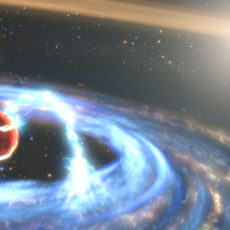
The NASA/ESA Hubble Space Telescope identified 25 hot Jupiter exoplanets that helped astronomers answer five open questions important to our understanding of their atmospheres. They discovered the presence of metal oxides and hydrides in the hottest exoplanet atmospheres was directly correlated with the atmospheres’ being thermally inverted. The data also contained eclipses for all 25 exoplanets, and transits for 17 of them.
Nearly all of the observed exoplanets with a thermally inverted atmosphere were extremely hot, with temperatures over 2000 Kelvins, which is hot enough that metallic species TiO (titanium oxide), VO (vanadium oxide) and FeH (iron hydride) are stable. With that said, of those displaying thermal inversions, nearly all of them were found to have H–, TiO, VO or FeH in their atmospheres. Astronomers believe that because the exoplanets absorb so much stellar light, their upper atmospheres heat up even more. In related news, Hubble also discovered an exoplanet with water vapor in the circumstellar habitable zone.
- POWERFUL REFLECTOR TELESCOPE: The Celestron AstroMaster 114EQ Newtonian telescope is a powerful and user-friendly reflector telescope. It features...
- NEWTONIAN REFLECTOR OPTICAL DESIGN: With a 114mm aperture, the AstroMaster 114EQ can gather enough light to see our Solar System and beyond. View...
- EASY TO SET UP AND USE: This is a great telescope for kids and adults to use together. It features a manual German Equatorial mount for smooth and...
A significant aspect of this research was that the team were able to use a large sample of exoplanets and an extremely large amount of data to determine trends, which can be used to predict behavior in other exoplanets. This is extremely useful, because it provides insight into how planets may form, and also because it allows other astronomers to more effectively plan future observations,” said the press release.





